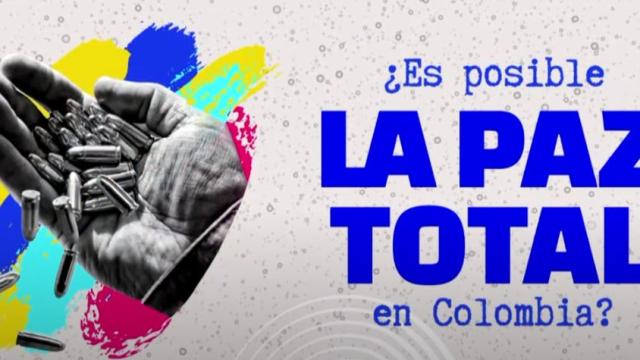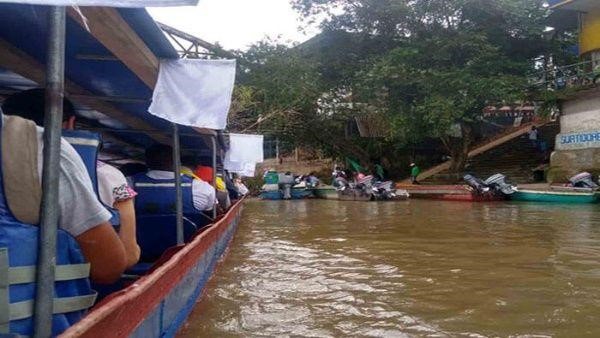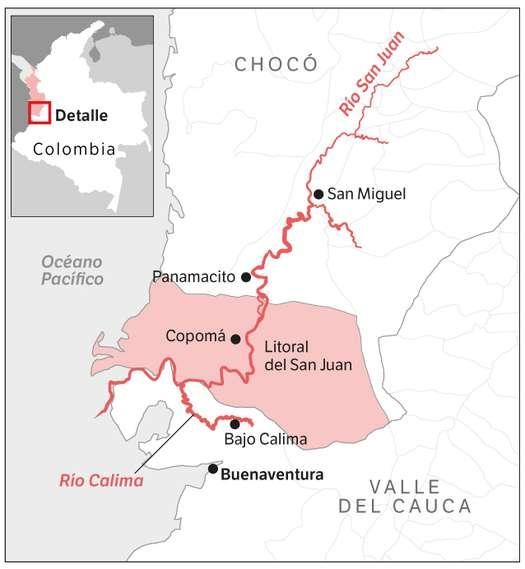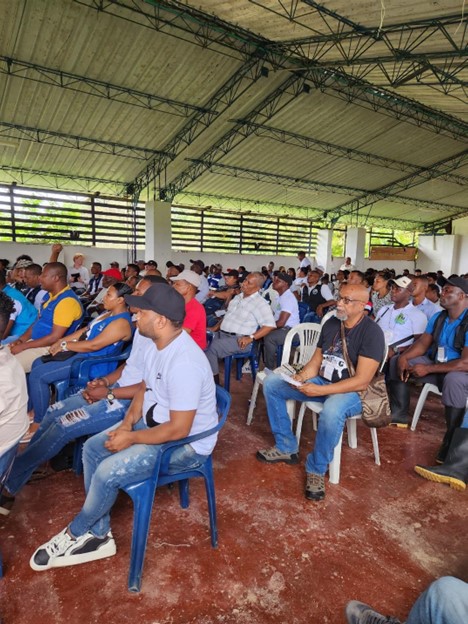Colombian Peace Caravan: Bringing the Hope of “Total Peace” to Afro-Colombian and Indigenous Territories


Image: ElTiempo.com
Ajamu Baraka representing BAP’s Haiti/Americas Team was invited to serve as part of an international delegation of human rights defenders that would accompany the activists, community leaders, government officials and representatives of the National Liberation Army (ELN) on an historic “humanitarian Caravan” between January 17 and the 21st to the Indigenous and Afro-Colombian areas of the Pacific coast of Colombia as part of the peace process initiated by the new government in Colombia. Ajamu was also an observer and international guarantor in Havana, Cuba during the last round of the Peace Process that produced the Ethnic Chapter of the peace agreement between the government and the FARC in 2016. This is his report back on the Caravan.
Total Peace is the Call
When the new Colombian administration of Gustavo Petro and Francia Marquez took office, President Petro announced that the administration would prioritize reviving the peace processes in the country. I was there in August that unusually sunny afternoon in Bogota, a city notorious for its foul overcast weather for the inauguration of the new Petro/Marquez administration. Perhaps it was the spirit of the thousands of people jammed into the plaza, exulting in an overpowering energy fueled by hope and the belief in the possibilities of a new beginning for this country that had been mired in violence and despair for so long that it pushed back the clouds and bathed all of us in the warmth of optimism.
It was a moving day to see our Vice President, Francia Marquez come on stage. A product of the Black movement, a woman of impeccable character who embodies our resistance, the hopes of the people, a young woman who I had seen grown up, who broke bread in our house and slept in our beds, who ended up under death threats for years, having to move with security details for the last eight or more years, now confidently assuming her place as the next Vice President of the country. When she came on stage there was not a dry eye among the contingent of Black activists that I had the honor to be with as a special guest of the movement.
Francia, who ran for president but was now Petro’s Vice President, campaigned on a commitment to reviving the peace process that had been subverted by the previous government. This commitment meant there had to be a real commitment to the terms of the agreement between the Colombian government and the FARC, the leftist political movement that had been in conflict with the government for over fifty years before entering into a “peace deal” with the government in 2016.
But the commitment to peace had to go beyond just attempting to implement all the provisions of the agreement with the FARC. The situation in the territories for the people had not only not improved but in most cases the violence, displacement and general insecurity had increased.
To address this reality, President Petro announced that the new administration would advance a process that he referred to as “Paz Total” or “Total Peace.” “Paz total” was a bold initiative that called upon all armed groups to join with the government to declare a unilateral ceasefire and enter into dialogue with the government.
A significant first step in this process was to revive the negotiations between the government and the National Liberation Army (ELN), the other major armed leftist organization in the country that has been in conflict with the government since 1964.
Two FARC dissident groups – the Central General Staff and Second Marquetalia – as well as the Gaitanista self-Defense Forces (AGC), and the Sierra Nevada de Santa Marta Self-Defense were also brought into a dialogue with the government.
The AGC is especially significant. Referred by members of the government and the people as the “Clan del Golfo,” the AGC is the largest paramilitary criminal group in the country that is responsible for a disproportionate amount of the violence experienced by people in the rural and urban areas of Colombia. Ultimately Total Peace, according to the Petro/Marquez government, would be arrived at through this process of engagement in which all of the armed groups in the country would eventually agree to terms that would result in them demobilizing or surrendering.
Humanitarian Caravan
The resumption of Peace Talks with the National Liberation Army (ELN), was announced at the beginning of October 2022, and the first meeting took place in Venezuela on 21 November 2022 moderated by representatives from Norway, Chile, Mexico, Venezuela, and Cuba, as well as representatives from the United Nations and the Catholic Church.
During this first round of talks, the Government and the ELN agreed to promote a system of humanitarian relief to guarantee the return of the displaced populations and put an end to situations of confinement generated by the violence in the regions.
Establishing a humanitarian caravan to assist with implementing the agreement on humanitarian relief was the first concrete agreement that came out of the dialoguesbetween the National Government and the ELN.
What was the objective? Diagnose the humanitarian situations in indigenous and African-descendant communities in the regions with the purpose of establishing the conditions for the communities to leave the confinement or, in cases of forced displacement, to return to their territories under the principles of dignity and security.
The process with FARC was a bilateral engagement between the FARC and the government. However, along with including armed paramilitary organizations like the Gulf Clan in a dialogue process with the government, the Petro/Marquez administration is attempting to bring an element into the discussions on peace by going to the territories most impacted by the ongoing violence. No other government, including the government of Juan Manuel Santos that initiated the process with ELN, had effectively included the people before.
The idea was that representatives of the communities would share their conditions and make recommendations. The impressions and written submissions will be compiled at the end of the caravan by the government and ELN delegates and shared at the negotiating table between the ELN and the government in early March in Mexico. The report will serve to adopt the specific humanitarian measures for communities at risk in the Colombian Pacific region.
The caravan began January 17 with an orientation in Cali, Colombia. Over 160 people participated in the caravan. Participants included leaders of the Bajo Calima Community Council, the San Juan General Community Council (Acadesan), the Valle del Cauca Association of Indigenous Councils (ACIVA), the Wounaan People's Council of Authorities of Colombia (Woundeko), social organizations and victims, members of the Catholic and Protestant churches, international agencies of the United Nations and the MAPP-OEA.
The caravan was accompanied by a small delegation of international human rights defender groups, peace organizations and international agencies of the United Nations. The Black Alliance for Peace was one of those groups and was represented by me, Ajamu Baraka from BAP’s Haiti/Americas’ Team.
The National Government was represented by Carlos Rosero, Dayana Domicó, Mabel Lara and Horacio Guerrero, members of the peace delegation, together with Juan Carlos Cuellar and Jairo Arrigui, from the ELN peace management team. They had the responsibility to liaison with the communities, recording testimonies and receiving proposals from the various stops.

After leaving Cali, the caravan moved en masse to the port area of Buenaventura and the town of Bajo Calima. The caravan was divided into two tours. One caravan traveled by boat to the middle and lower San Juan to visit the towns of San Miguel, Noanamá, Negría and Panamacito.

The other went by boat from Bajo Calima (Valle) until reaching Docordó (urban head of the Litoral de San Juan, in Chocó) on the way visited the communities of La Colonia, San Isidro, Valledupar, Palestina, Cabecera, Unión Balsalito and Docordó.
What did we see and hear?
Bajo Calima and Medio San Juan are areas where Africans and Indigenous peoples have inhabited for centuries. Africans escaped from enslavement and tried to distance themselves from the Spanish as far as they could. Often ending up in remote areas of the country sharing territories with the Indigenous who themselves were subjected to brutal forms of slavery and various forms of forced labor.
It has only been in the last few decades of the 20th century that the lives of the peoples of these territories have been significantly disrupted. First with the expansion of the armed struggles in Colombia, the invasion of their lands by “colonialists” engaged in illegal lumber, mining and then drug activity and then the arrival of the state, usually the military apparatus.
Today narco-paramilitaries and other armed groups associated with multinational corporations, the ELN and the state’s military and police forces are all locked in a battle over hegemony within the territories with the people paying a terrible price as a result.
Moving down the San Juan river on boats flying white flags hoping that the negotiated agreement to allow the caravan to proceed unimpeded through territories being contested by the ELN, the Clan del Golfo and the state, the story that we encountered was the same.

Meeting with the communities under tin roofs of community centers packed with members of the caravan and the designated members of the community who were elected to speak, itself a responsibility not taken on lightly since it was not clear if there would be any retaliation for what might be said to the caravan delegation and their international guests.
What the people talked about was life that had been severely disrupted by various groups imposing confinement on the communities where they couldn’t live their villages or sometimes their houses for extended periods of time. This meant they could not get to their farms to tend their crops, or fish or get to the mines. It meant economic life came to a standstill and people went hungry.
They talked about forced recruitment by the armed actors of their young people. They shared the incidents that finally forced them to flee their territories, the collective punishments, the killings that took place in public to terrorize the community. There were tears but also a resiliency that reflected that for many of these communities they had reached the point where they were willing to risk everything in order to defend their dignity, and their cultural and economic life.
And what did they think about the peace process? For some they had seen it all before. They knew about the agreements with the FARC and the Ethnic Chapter of the agreements that were supposed to make the lives of the Indigenous and Afro-Colombian peoples in the rural areas better. But all they say instead was more violence and more social instability when new groups of “men with guns” filled the power vacuum when the FARC disarmed and demobilized.
For many of the people, peace was still an elusive term that seemed to only exist in the minds of government bureaucrats, NGOs and the people who did not understand the realities of the territories.
Did we see hope? We did not see hope in the liberal sense of some abstract positive thinking divorced from reality. What we all saw was a determination in some communities that their plight could not be dependent on decisions made hundreds of miles from the realities of their lives in their communities. With the formation of their local guards and a commitment that they were going to live in freedom, it was clear to me that these communities were prepared to pay the terrible toll that is demanded when you struggle for freedom.
A Land of Tears and Hope
As stated previously, many of the people say they have heard it before. Once again, they are being told that there might be the possibility of peace in their territories where the guns would be lowered and removed, the displaced would return, communities allowed to go to their farms and their youth liberated from being forcefully recruited. Dignity and security were right around the corner.
That hope is reflected in the fact that the ELN and the government created a space for the people to have a voice, to participate. But those declarations of total peace will be, must be tempered by the real forces and their interests operating in those far-off spaces away from the centers of governmental power.
The people said over and over again that they wanted the men with guns out of their territories. They made no distinction between the armed factions of the ELN, the narco-paramilitaries or what they referred to as “public authorities” – the state.
But why would the men with guns leave as long as there exists the ability to make tremendous amounts of money in the territories?
Officials in the Petro/Marquez government are reaching out to impoverished coca farmers hoping to revive interest in the idea of substituting coca production for coffee and other high-value crops.
Yet, for many observers of the complex situation that Colombia offers, the Petro plan seems to defy the logic of the capitalist interests at play.
According to Mike Vigil , a former DEA agent stationed in Colombia during the Pablo Escobar era, the narco-paramilitaries will never leave on their own accord as long as illicit drugs remain such an incredibly lucrative business. For these elements, “negotiating is a stalling tactic where they buy time. They’re able to generate more money and become more powerful.”
Because control of territory and profits are fundamentally linked with the global cocaine trade, peace in the territories that does not include forcefully pushing the criminal elements out makes President Petro’s plan seem a little utopian.
The people, however, do not want to see more conflict in their regions. There was a real reluctance to allow further militarization in the territories, even by government forces. Many communities had come to the conclusion that the renewed violence between armed groups in the region and aggressive military operations that at times did not discriminate between armed combatants and the residents, demonstrated that the state could not guarantee security in their communities and territories.
Although, much of the feedback from the communities did not seem to indicate how the people thought security could be guaranteed. The commitment between the government and the ELN to address the humanitarian needs of the people will likely be ratified. But what about the other armed actors?
In the immediate future within the territories, cocaine is one of the main crops the people grow to make ends meet. But as we saw and heard on the caravan, the battle over control of that production along with the illegal mining and lumber activities has made living in the territories extremely precarious
The strategy of the Colombian government - creating partial agreements with the ELN and discussing different issues in each round of negotiations has some potential. What is much more of a challenge is are the armed groups still addicted to the cocaine trade with the material means to protect their interests no matter what the government or the people want.
However, even with the process with the ELN, the government failed to fully implement the agreements with the FARC-EP. As of late 2021 it was reported that “only 30% of the 578 stipulations in the Peace Accord had been implemented.” And while the Petro government is not the right-wing government of Ivan Duque where the implementation of the Peace Accord was almost completely abandoned, the ELN will need to have confidence that the government will deliver on its side of any agreement. The connection between successful negotiation between the ELN and the government is contingent on progress made to revive and implement the accords with FARC – EP.
In the meantime, the conditions do not yet exist for a sustainable peace and national reconciliation process. The objective economic and political interests represented in the state and the legal and illegal economic activities of various entities suggest that before peace can be achieved, the peoples in the regions may have to go through a period of further violence.
But perhaps this time it might be the communities taking the prospect of peace into their own hands by eliminating the elements that continue to bring them so much suffering.
Ajamu Baraka is the national organizer of the Black Alliance for Peace and an editor and contributing columnist for the Black Agenda Report. Baraka serves on the Executive Committee of the U.S. Peace Council and leadership body of the U.S. based United National Anti-War Coalition (UNAC) and the Steering Committee of the Black is Back Coalition.